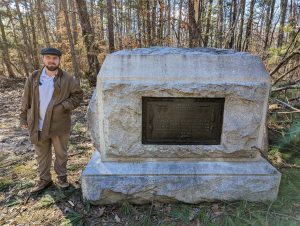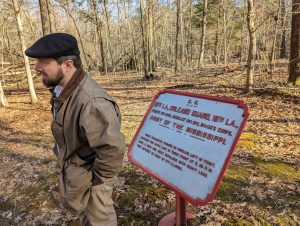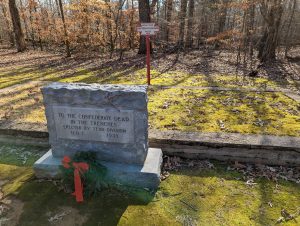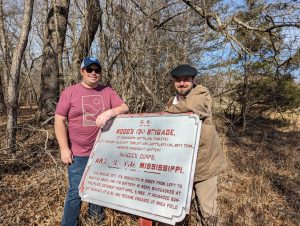A Visit to Shiloh in 2023
My two favorite places in the world are the French Quarter (where I live) and Shiloh National Military Park. I have been thinking about Shiloh since I read a short account of the battle in 1997 and then played the TalonSoft game and bought Larry J. Daniel’s account. I did not make it to the battlefield until 2002. Since then I have been in 2011, 2019, and most recently in 2023.

In many ways the latest visit was the best of the bunch. I went with my brother Daniel Chick and my old friend Ashley Dunham. Both wanted to visit as they have seen me work on several Shiloh books since 2018. Progress has been slow for many reasons, not the least my decision to go all out with the research and expand it into writing several books instead of one. The bibliography is approaching 102 pages.
Daniel wanted to go because he likes battlefield visits and Shiloh is considered a gem. I showed him some of the spots where our ancestor Samuel Chick was with the 44th Tennessee. I never knew I had an ancestor at the battle until I did genealogical research in 2017. I am also certain he was not with the 44th Tennessee through the whole battle. The unit’s effective strength decreased as the fighting wore on and Samuel Chick, after fighting at Perryville, deserted on the eve of Stones River. Who knows, maybe he did charge across across Water Oaks Pond on April 7? I do not think so given his later actions.
Ashley was the one most excited to go. Two of her ancestors were there, brothers Charles and Eugene LeBlanc. They were with the Orleans Guard Battalion, a unit of elite Creoles who volunteered to go north when P.G.T. Beauregard, a former member of the unit, called for help. Looking at the rolls of the battalion is like seeing the names of friends, coworkers, acquaintances, and others from times past and present: Guilbeau, Bienvenu, Delahoussaye, Gauthier, Landry, Dupre, Dupuis, Robichaux, Broussard, Guidry, etc.

Eugene LeBlanc died at Shiloh on April 6. The Orleans Guard Battalion took most of its losses on April 6 charging near Cavalry Field. That is likely where he died, his body left after the battalion made a doomed attack. He was likely buried in a trench nearby which can be visited. His brother survived the battle and the war.

I described to Ashley the fight where Eugene Leblanc died and the other engagements of the Orleans Guard Battalion, including their part in a desperate counterattack in the early afternoon of April 7. By then P.G.T. Beauregard knew all was lost but he could not retreat right away. He made a series of attacks meant to hold off the Federals while the rest of the army went south. At one point he grabbed the banner of the Orleans Guard Battalion and led them into an attack. While LeBlanc left no recollection, the Orleans Guard’s story is related in The Shiloh Diary of Edmond Enoul Livaudais, one of the best Shiloh accounts. I also described to Daniel the part played by the 44th Tennessee. The regiment was right near where the battle started. In the early morning they saw the 3rd Mississippi Battalion trade shots with James Powell’s patrol made up of men from the 25th Missouri and 12th Michigan.

These personal moments were excellent and it was good to share these stories. I had my selfish reason to visit as well. I wanted to meet with Stacy Allen, who manages the park. I had some primary sources to donate but forgot those, but I will mail them in time. I plan to turn over all of my research to the park when the books are complete. Lastly I wanted to visit those parts of the park I had not yet seen. I wanted to finally go to Spain field where Benjamin Prentiss’ division was shattered after a determined fight. I wanted to go to Sowell Field, where Lew Wallace’s division held the Federal right on the late morning of April 7. I finally made a close inspection of Jones Field, scene of important fighting on both days. I have worked on maps of this battle for years, figuring out the minutia of what some consider the Civil War’s most confusing battle. And with any luck I will go there again to wander down other trails I have yet to step along, thinking back to vivid accounts left by Ambrose Bierce, Henry Stanley, Daniel McCook, Edmond Enoul Livaudais, Leander Stillwell, Sam Watkins, and the many others. For them Shiloh was the definitive moment of their lives. As Bierce wrote in what I still consider the best account from the conflict,
“O days when all the world was beautiful and strange; when unfamiliar constellations burned in the Southern midnights, and the mocking-bird poured out his heart in the moon-gilded magnolia; when there was something new under a new sun; will your fine, far memories ever cease to lay contrasting pictures athwart the harsher features of this later world, accentuating the ugliness of the longer and tamer life? Is it not strange that the phantoms of a blood-stained period have so airy a grace and look with so tender eyes?—that I recall with difficulty the danger and death and horrors of the time, and without effort all that was gracious and picturesque? Ah, Youth, there is no such wizard as thou! Give me but one touch of thine artist hand upon the dull canvas of the Present; gild for but one moment the drear and somber scenes of to-day, and I will willingly surrender an other life than the one that I should have thrown away at Shiloh.”
Did you know Otis Edward Cunningham taught Civil War at Tulane? He was a disciple of T. Harry Williams.
I did not know but he did write my favorite book on Port Hudson.
How much has it changed in these years of your visits. More monuments? Better interpretive markers? Nicer Visitor Center? Closer in encroachment of the economy? Thanks for a fantastic article.
Not much I have seen although they are redoing the visitor center right now.
You mention “books” in the plural concerning Shiloh. Are you planning to do a multi volume work on the entire battle or separate books on different aspects of the battle? Either way, it is a great topic and great battlefield.
I am writing Maps of Shiloh, two volumes on Shiloh, and an introductory book for Casemate.
Enjoyable article-thanks.
Big fan of all of your work and podcasts on thersites.
Some argue we have been biased into thinking the heaviest fighting was only at “not-so-sunken-road”, hornet’s nest and the peach orchard area. Not to say those areas weren’t intense, but in your research, would you argue other areas of the battlefield deserve more attention for heaviness in fighting? If so, which stand out? Thanks.